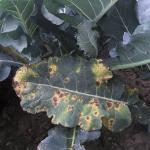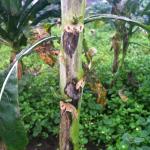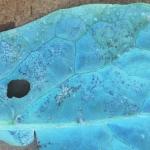Brassicas, Fall Insects and Diseases
Fall with cooler temperatures and shorter days is the time when fall brassica crops tend to look terrific. Fall is the easiest time to grow high quality broccoli. Flea beetles seem to evaporate (though they can sometimes be found in some fields in mid September), as they depart the field for overwintering sites in the border. Caterpillars grow more slowly, so that as long as you don’t ignore them completely, they are easy to control. However, its worth keeping a close eye on these crops, especially by looking underneath the leaves. As usual, that is where you will be able to notice problems early, and avoid having them sneak up on you.
Alternaria Leaf Spot (Alternaria brassicae, A. brassicicola)
For more detailed information on Alternaria leaf spot, please see our main Brassicas, Alternaria Leaf Spot article.
Alternaria leaf spot is encouraged by heavy dews that kept leaves wet for long periods. At least three species of Alternaria can cause serious losses in brassicas. It occurs on many brassica crops, including Brassica oleracea types (eg broccoli, cabbage, collard) and Brassica rapa types (eg, bok choi, tatsoi, komatsuna) (see photos). These pathogens may be seed-borne, both as spores on the seed surface and as mycelium within the seed. However, the major source of inoculum is crop debris in soil.
Symptoms of Alternaria are circular, small, dark spots with concentric rings (target spots) on the upper surface of leaf. Older leaves are more susceptible to infection. When humidity is high, lesions can be covered with a sooty black mass of spores. The pathogen sporulates abundantly on foliar lesions and centers may fall out to give a ‘shot-hole’ appearance. Lesions can grow together leading to large necrotic areas and early leaf drop. Symptoms on cauliflower and broccoli heads begin as browning at the margins of individual flowers. ALS requires leaf wetness for 16 hours to initiate infection and at least 12 hours of continuous humidity at >90% RH to develop. Note that if Alternaria does not have the required amount of leaf wetness, it will appear as tiny black “sooty” dots (not as the characteristic target-spot lesions).
Alternaria leaf spot can cause economical loss in storage if infection spreads into the upper frame leaves or head due to additional trim loss, the production of ethylene, and invasion by secondary fungi and bacteria. Alternaria infection can be mainly cosmetic, but results in crop rejection by distributors and customers. Infection of broccoli and cauliflower heads can lead to complete deterioration of the heads and result in total loss of marketability. Affected cabbage do not store well as lesions provide entry for secondary soft-rotting organisms. Control of Alternaria leaf spot on cabbage heads in the field is necessary for long-term storage. Heavy infections of foliage reduce plant vigor and yield. Pod infections cause distortion, premature shattering, and shriveled, diseased seed that germinates poorly.
Because inoculum carries over in crop residue, crop debris should be destroyed as soon as possible after harvest and a minimum 3-year rotation out of crucifers should be used. For rotation to be effective, cruciferous weeds need to be controlled during the rotational period. Buy seed from a reputable source or treat with hot water to eliminate Alternaria from seed. Eliminate cull piles. Avoid overhead irrigation during head development.
For current chemical recommendations, see the New England Vegetable Management Guide.
Powdery Mildew
This disease is unusual in the US, but is reported to occur regularly in England and southern Ontario, among other locations, especially on rutabagas and turnips. The disease is unusual in New England, but it does occur. Brussels sprouts, kale, Chinese cabbage, collards, broccoli, mustard and cauliflower are also reported to be hosts. Just as you would expect, the symptoms are white talcum-like growth on the upper leaf surface, starting as circular patches and expanding to cover the leaf. Leaves become pale green to yellow or tan, or if severely infected, curl and die. The plant is rarely killed, but growth can be stunted or defoliated, and of course is the leaves are sold, the disease would render them unmarketable. Note that this is a different species of powdery mildew than those that infect cucurbits, or tomato, or various ornamental crops.
Conditions that favor this disease seem to be low relative humidity with cool temperatures, water stress of the crop, and the availability of a thin film of moisture in which spores can germinate. The white powdery growth includes mycelium and spores (conidia), which can be dispersed quite long distances by wind. Spores overwinter “with difficulty”; however, survival of the fungus is better when live plant material carries over through the winter, which enables the fungus to produce new spores in the spring. It seems possible that we may see this disease more often if we start to have consistently milder winters which allowed survival of brassicas, and because growers are overwintering Brassica plants through protection with row covers. If you see powdery mildew this in fall, don’t ovewinter those Brassicas!
Fungicides which are labeled for fungal diseases of Brassicas, especially those which also work against powdery mildew in other crops, should provide control of the disease. Apply at first indication of disease. Put crop residue under as soon as possible after harvest, control Brassica weeds which could also harbor the disease.
Downy Mildew (Peronospora parasitica)
For more detailed information on downy mildew of brassicas, please see our main Brassicas, Downy Mildew article.
Downy mildew of brassicas should not be confused with downy mildew of cucurbits (caused by Pseudoperonosproa cubensis), which is related but does not infect brassica crops. Downy mildews tend to be specific to a certain plant family or even species within a plant family. They are in the same group of fungal-like organisms (oomycetes or ‘water molds’) that cause late blight of potato and tomato and blue mold of tobacco.
Downy mildew is an important disease of broccoli, collards, kale, cabbage, cauliflower and Brussels sprouts. It can also infect rutabaga, turnip and radish. The disease caused by Hyaloperonospora parasitica is particularly important on seedlings but can also cause poor growth and reduced yield and quality of produce at later plant stages. Plants can be infected at any stage of growth. It is encouraged by cool, moist conditions (from rain, heavy dew or fog), which are more typical in late August, September and October in our region. Infection can occur at any stage of growth. Severe infections can kill seedlings, but stem, leaf and flower/head infections can cause crop injury and loss at later stages. Affected tissues become susceptible to attack by secondary rotting organisms. Downy mildew also attacks the taproots of turnip and radish and infected organs develop a black, epidermal blotch and an internal discoloration.
The most distinctive symptom is grayish white, fluffy growth on the undersides of leaves. Irregular, angular yellow to brown spots develop on both top and bottom of the leaf. In the floral parts of broccoli or cauliflower, dark brown areas develop internally in curds or floral buds of the head. Stems and stalks of the flower head may be darkened or have black streaks, and this may be the first sign of infection in broccoli. In cabbage, internal darkening and purplish spots appear in the inner layers of the head or move upward in the head from stem infections. Secondary infection with soft rot bacteria (always smelly!) may follow the downy mildew. In cabbage, systemic invasion of the stem may occur after infection of the lower leaves. The fungus may then invade the head leaves and sporulate after the cabbage has been stored.
The fungus survives from season to season as thick-walled resting spores, called oospores. These sexual spores can survive in the soil for extended periods and produce sporangia when conditions are moist and cool, especially at night. Disease development is favored by abundant moisture on leaves provided by dew, drizzling rain, or heavy fog. Sporulation, germination, and reinfection can occur in four to five days. The fungus may also survive in a latent state within systemically infected plants. Oospores and mycelium can be carried in and upon seed. Secondary spread of the pathogen occurs by asexual spores (sporangia). Sporangia carried on air currents and on wind-blown rain germinate on leaves and produce new infections. The pathogen is favored by cool, moist conditions.
Cultural controls for downy mildew
Rotation out of brassicas for at least two years; removal of crop residues which contain Oospores (may not be practical!); adequate crop spacing to encourage drying of leaves. Control in the seed-bed is very important and includes the use of clean growing medium, good drainage, and an avoidance of overhead irrigation. Resistant or tolerant varieties of broccoli have been developed; our sources list Marathon and Arcadia among these. Practice rotation with non-brassica crops. A two-year rotation away from brassicas is an important management step. Manage Downy Mildew on transplants in the seedling bed by improving air circulation, irrigating early in the day, and applying fungicides. In the field, lower leaf wetness periods and humidity in the plant canopy by increasing spacing, controlling weeds, planting in the direction of prevailing winds, and planting in areas that get full sun.
For current fungicide recommendations, please see the New England Vegetable Management Guide. Preventive spraying of protectant foliar fungicides may be necessary if environmental conditions favor disease development.
Black Leg (Phoma lingam)
For more information on black leg, please see our main Brassicas, Black Leg article.
Black leg, caused by the fungus Phoma lingam, affects many cruciferous crops, especially cauliflower, broccoli, and turnip. Rutabaga, radish, and mustard cultivars are only slightly susceptible. This disease can spread rapidly within a field. Though it is favored by wet conditions, it may spread on seedlings in the greenhouse and cause problems even in dry, sandy fields.
Plants can become infected at the seedling stage or at any stage in the field. The initial source is probably infected seed. The disease has become less important in brassica crops because of successful disease management strategies in seed production. Once present on the farm, management should focus on avoiding spread of the disease, and rotating out of the infected field for four years to eliminate the inoculum. Rogue diseased plants from seedbeds. Improve soil drainage and air circulation. Control cruciferous weeds. Incorporate crop debris promptly after harvest to hasten decay. Avoid working in the fields when wet.
Symptoms of the pathogen start as slight lesions on stems at cotyledon stage which elongate, turn brown with a black to purplish border, and become sunken. The lesion extends up and down the stem, the stem becomes girdled and blackened, with many fruiting bodies (pycnidia) embedded in the tissue. Lesions may extend below the soil and attack roots. Diseased plants often wilt, lodge, and die. On root crops, symptoms occur in the form of cankers on the fleshy roots and a dry rot may appear in storage. Phoma lingam can survive for up to four years in seed and three years in infected crop debris. The pathogen infects seedlings, forms pycnidia, and produces abundant amounts of spores which exude from the pycnidia in long coils and are splashed to nearby plants to initiate new infections. The disease is favored by wet, rainy weather. Start with seed certified as disease-free or treat seeds with hot water.
Chemical recommendations: For organic growers: potassium bicarbonate (Armicarb 100): 2.5 to 5.0 lb/100 gal (0 dh, REI 4h).Start application at the first sign of disease and continue at 7-14 day intervals while conditions remain favorable for disease development.
Non-pathogenic disorders of broccoli
Several physiological disorders affect brassicas, especially broccoli. Those that affect broccoli include brown bead, heat injury, and hollow stem. Each of these disorders can be caused by a combination of factors – heat stress during head initiation, excessive water especially after a dry period, excessive nitrogen, rapid growth during head formation, deficiency of boron, and cultivar susceptibility.
Heat injury is most often manifest as unevenness of the crown and uneven bud size on the head, as well as small head size.
Brown bead appears as heads approach maturity and is usually associated with rapid growth during periods of high temperature followed by abundant rainfall. Floral buds turn tan or brown and become easily detached. These may then become infected with soft rot bacteria.
Boron deficiency, which can manifest as hollow stem of broccoli or cauliflower, brown discoloration of turnip or rutabaga roots, or internal discoloration of cauliflower, can be more severe if plants are water stressed or pH is greater than seven. Adequate supplies of soil organic matter, consistent and adequate water levels in the soil, and supplemental boron applied before planting if boron levels are low can all help in avoiding these problems.
Cabbage aphid
For more detailed information on cabbage aphid, please see our main Aphid, Cabbage article.
Cabbage aphids tend to build up in fall brassicas. Cabbage, cauliflower, broccoli and Brussels sprouts are most severely affected, but other crops may become infested. These are gray-green aphids with a waxy coating that makes them appear whitish gray. Winged aphids arrive, and produce colonies of wingless nymphs that also reproduce. They overwinter as eggs, which are laid on the undersides of leaves of the same crops or weeds that were fed on during the summer. There are multiple summer generations and potential for huge population growth, especially where long-season crops (e.g. Brussels sprouts) are infested early. Colonies tend to form in younger, upper leaves, in cabbage heads, between cauliflower curds, or in long-season brassicas such as Brussels sprouts. Dense colonies may develop, which can stunt plants or cause curled leaves, and will contaminate harvested parts.
Biocontrols (predators and parasites, and a fungal pathogen) often keep colonies under control; however, if numbers are building, insecticides may be needed. University of Connecticut recommends a threshold of 10% infested plants in cabbage, broccoli, cauliflower and Brussels sprouts after heads or sprouts begin to form. Natural enemies can suppress cabbage aphid populations, but may not be able to prevent or control high densities that can occur in cool fall weather. Predators of cabbage aphids include syrphid fly larvae and ladybugs. The tiny ichneumonid wasp, Diaeretiella rapae, is a parasitoid of cabbage aphid—female wasps lay eggs within the aphids and the resulting larva consumes the aphid from within, creating a round, bronze-colored “mummy”. These natural enemies can be attracted to brassica fields by planting flowers that provide them with nectar and pollen.
Incorporate crop residues immediately after harvest or, for late-fall brassicas, as early as fields allow the following spring. Control brassica weeds in or near fields. Always check transplants to be sure they are aphid-free. Early-season aphid infestations may originate from greenhouse infestations. Reflective mulch can be used to repel aphids. Scout for cabbage aphids weekly beginning in early June. If isolated patches of infested plants are found, removing those plants from the field and destroying them can help avoid their spread.
There is a range of chemistries available among insecticides labeled for this pest: including pyrethroids and organophosphates, neonicotinoids, pymetorzine, and insecticidal soap. Note plant back limitations or limits on which brassicas are allowed. Always uses a spreader sticker to obtain better coverage and more insecticide persistence. Insecticidal soaps are capable of reducing cabbage aphid and are relatively easy on natural enemies. Soap are quite effective as long as the material contacts the pest at the time of application, but they have no residual activity once they have dried. Ensure good coverage of the undersides of leaves. Several applications may be needed. See the New England Vegetable Management Guide for current chemical recommendations.
Cabbage root maggot
For more information on cabbage root maggot, please see our main Cabbage Root Maggot article.
Cabbage root maggot can cause root injury in fall turnips and rutabagas. Timing of controls is more difficult than in spring crops, and root crops are more sensitive to injury since the root is marketed. The adult flies are active in early September, but the precise flight period is not well known and not easy to detect. The only labeled chemical control is Lorsban, which may be directed to the base of the plant and has a 30 days to harvest interval. Non-chemical controls are in short supply. In 2005, two growers in the UMass Brassica Project evaluated row cover to exclude maggot flies from fall root crops and found the cover reduced yield (and enhanced aphids).
Cultural controls include rotating crops to keep maggot populations low (greater distances are more effective), delaying planting until after first flight is done (usually mid-May, depending on growing degree days) and soil temperatures are high enough to kill eggs (95°F), covering recently seeded or transplanted crops with floating row covers, and tilling under fall crop residue to expose and help reduce populations of overwintering pupae.
Biological controls for cabbage root maggot include encouraging the natural enemy population, as well as introducing nematodes into the soil. Soil-dwelling beetles, including ground beetles (carabids) and staphylinid beetles, feed on cabbage maggot eggs, larvae, and pupae and can cause high levels of mortality. One staphylinid species, Aleochara bilineata, also parasitizes maggot larvae and has been shown to respond to chemicals given off by plants that suffer maggot damage. Because these soil-inhabiting beetles are susceptible to insecticides, broadcast soil insecticide treatments should be avoided. Other natural enemies including parasitic wasps and predatory mites. Soil application of the entomopathogenic nematode Steinernema feltiae has shown efficacy against cabbage maggot in trials even at low soil temperatures 50°F/10°C).
The Center for Agriculture, Food and the Environment and UMass Extension are equal opportunity providers and employers, United States Department of Agriculture cooperating. Contact your local Extension office for information on disability accommodations. Contact the State Center Director’s Office if you have concerns related to discrimination, 413-545-4800 or see ag.umass.edu/civil-rights-information.



